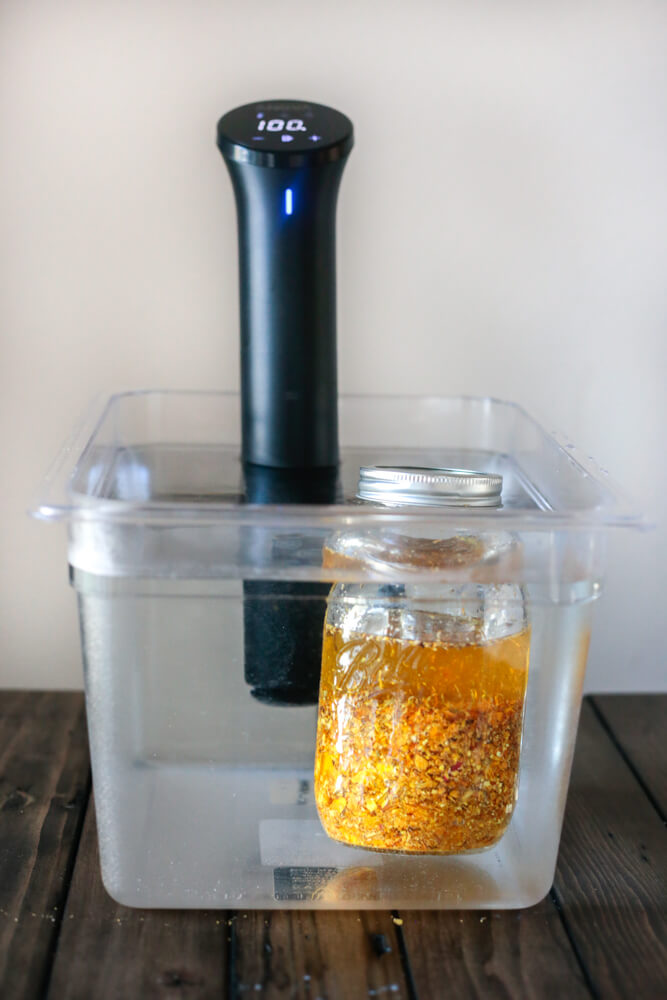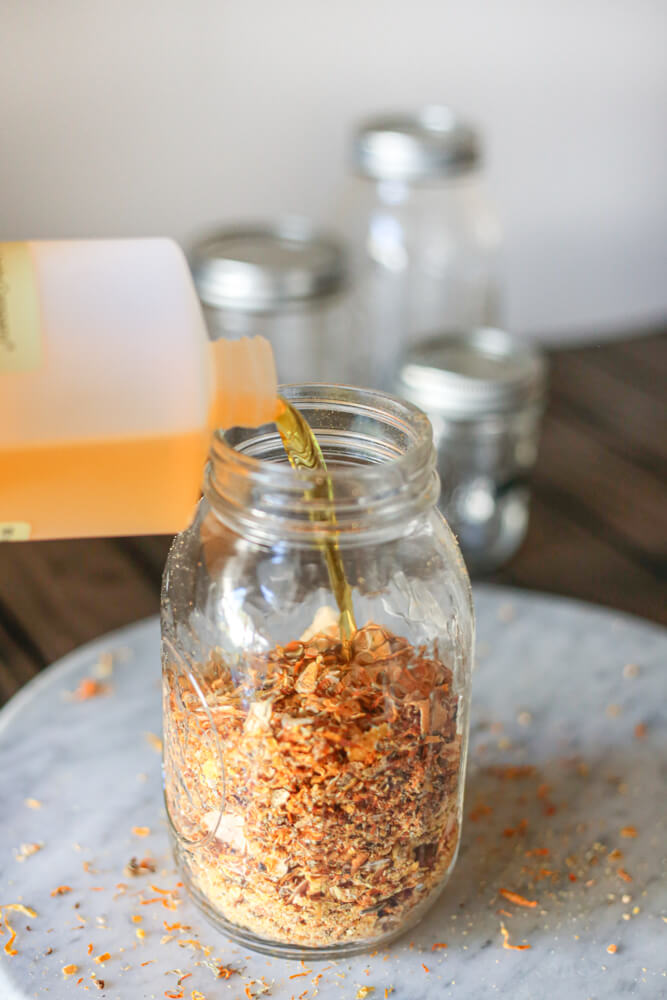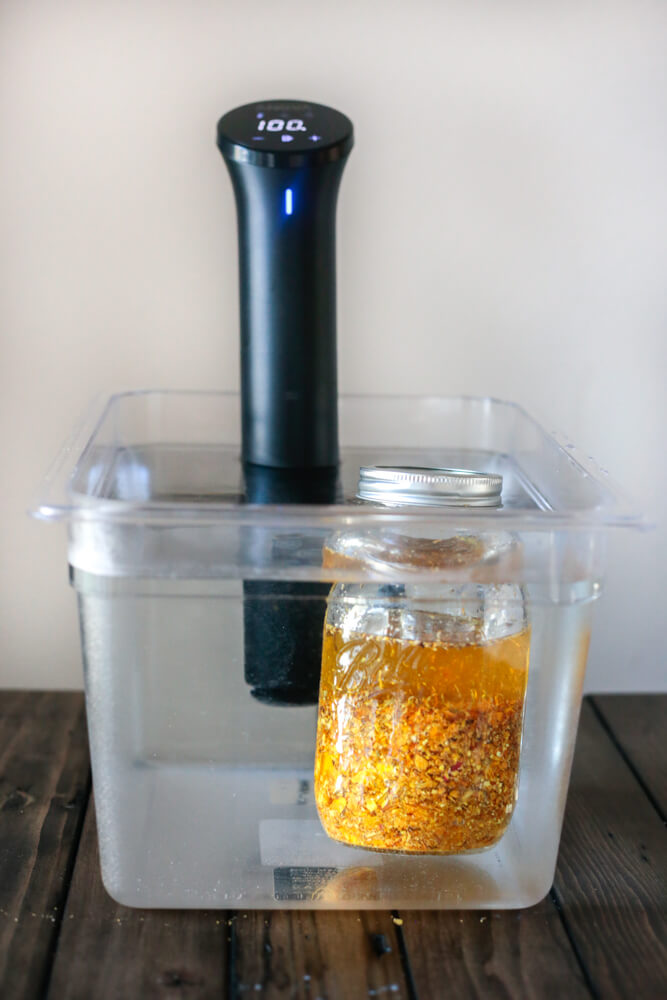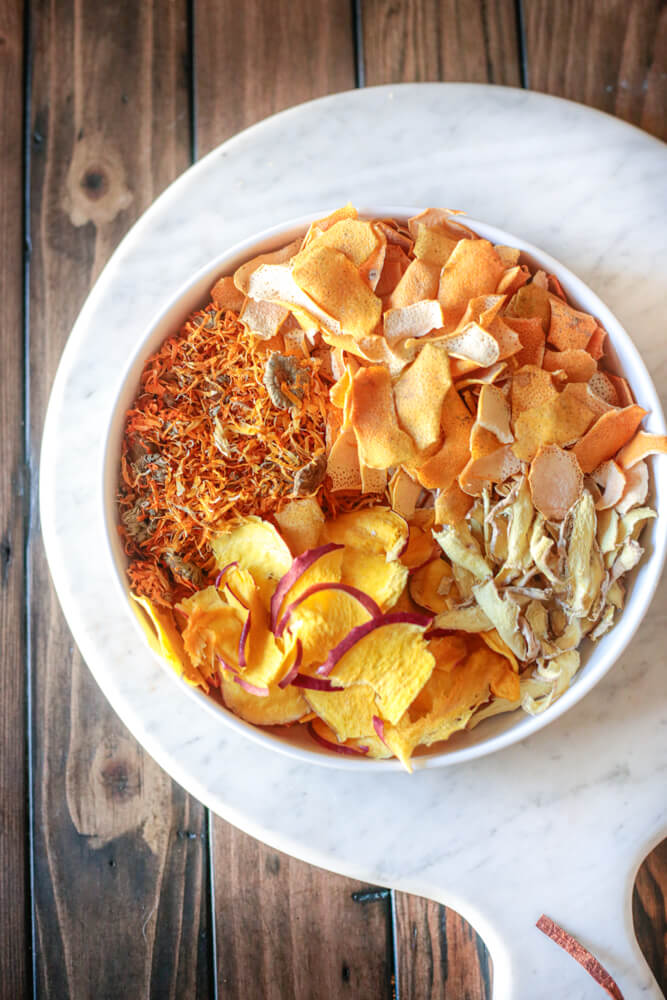
Herbal oils are full-body wellness, benefiting not only the skin, softening and soothing, but also on a deeper level, bringing wellness within.
In this article, I’m sharing how to use a sous-vide machine, to make an herbal oil. If this is something you’re interested in learning about – I’ll show you how a sous-vide can help you create a consistently potent, healing herbal oil.
What are Herbal Oils?
Herbal oils are an exchange between plant and oil. During the process of infusion, the herbs release their medicine – the constituents, volatile oils, nutrients, and oil-soluble vitamins – into the oil.
And when you apply it onto your skin – the oil gives your body the benefits of the herbs, from the outside in.
Herbal oils are potent – but incredibly gentle and can (and should) be used daily. With each herb, offering different benefits – an herbal oil can be used to support different needs: to clear ear infections, to soothe eczema or to restore a tired body.
How Do You Use Herbal Oils
You can incorporate herbal oils into your daily routine, massaging your entire body before you take your shower. This herbal self-massage is a transformative practice, that I think is underrated in the wellness world. Whether it’s for yourself, a family member or a client that you’re working with – integrating herbal oils and self-massage can help to make such a positive difference.
Here are some benefits of massaging your skin daily with herbal oils:
1. Herbal oils can support different systems in the body from circulation to digestion, respiratory, and skin.
2. Massaging with herbal oils activates the parasympathetic system, putting the body at ease.
4. Massaging with herbal oils stimulates circulation, the lymphatic system and promotes flow in the body.
5. Self-massage tones the skin, and muscles.
6. Massaging with herbal oils softens and nourishes the skin.
How do you Infuse Oil?

When you make tea at home, you are infusing. Water extracts out the herbal medicine, and when you drink it you receive those benefits. Well, oil can also extract out herbal medicine.
To infuse an oil – you begin by filling a glass jar 1/2 – 2/3 of the way with dried herbs. You can also measure it out: 1 oz of herb for every 10 oz of oil.
You then pour the oil in, fully covering the herbs. With the herbs saturated and submerged in the oil – the infusion process automatically begins.
You can either let it infuse in the “cold method” which is to let it sit for 6 weeks before straining the oil.
Or, you can use the “warm method”, which is to gently warm the oil, encouraging the extraction to happen quicker, one week.
Cold vs. Warm Infusions:
COLD METHOD: The biggest benefit to the cold method – is that you don’t need to invest in any equipment, or worry about monitoring temperatures… with just a glass jar and your ingredients – you can get started today!
I have been infusing oil using the “slow and cold” method for years. It’s easy, practical and inexpensive. But when you get into making your own herbal oils, if you’re making herbal skincare for your community – you might want to have it sooner rather than later.
WARM METHOD: The biggest advantage to the warm method is that you can help nature do it’s work, faster. What takes 6 weeks, can be done in one week. I know – one week may not seem “fast” – especially when we live in a time of same-day delivery. But considering the transformation that’s occurring between the herbs and the oil, that’s pretty amazing!
Can I Infuse in Less Time?
Ask a room of herbalist, and you’ll get different answers. Some say you can infuse an oil in hours, some say 1 day, 3 days…
I have personally found that in just a couple of hours, you can extract many of the volatile oils (the scent and flavor of the herb) using the warm method.
But to create a truly medicinal and potent herbal oil – I look to one of my favorite herbal teachers, James Green. In his book “The Herbal Medicine Makers Handbook” he recommends infusing oil at 100 degrees f, for 10 continuous days!
So that gives you quite a range of infusion times… you can do 1 day or 10 days…
For me, I find that somewhere in between, around one week of infusing, creates an oil infusion that is incredibly healing and potent. For example, when I infuse my calendula oil for one week – I can smell, see and feel the medicine in the oil. It turns yellow, the oil feels richer with all the resin and medicine, and it feels nourishing to my body.
What doesn’t change in advice – is the recommended temperature. To preserve the integrity of the oil, we want to keep the temperature at 100 degrees Fahrenheit.
The crockpot, unfortunately, can get too hot for infusions, and most ovens don’t set at that low of a temperature (some people use just the pilot light as the heat source) The surest way that I have found to infuse my oils at precisely 100 – is using a sous-vide.
Sous-vide for Infusing Oil

A sous-vide is a heating element that goes into the water and allows you to cook food very consistently. Usually, you would add the food item, like steak, fish or vegetables into a vacuum-sealed bag and cook it in a temperature-controlled water bath.
I bought my sous-vide specifically to infuse oils. The model I have is the Anova Sous-Vide Precision Cooker, and it was $94 on Amazon – and it does the job perfectly each time.
The heating element has a clamp that allows it to sit on the edge of a bucket or a big soup pot filled with water, which it begins to heat up at whatever temperature you set it to.
I love that the sous-vide element fits into any size pot, giving you the room to make as little or as much herbal oil as you need. The process of infusing the oil with a sous-vide is a lot like “canning” where you submerge the jars of oil and herbs into the warm water.
You can do several jars at once, which I recommend because if you’re going to go through the week-long process, you may as well get the most out of it.
For personal use, for family and friends – you might do a couple of 8-oz canning jars, each filled with a different blend.
If you are making infused oils for your soap business, your skincare line or to support your clients – then you can make larger amounts.
Step-by-step Guide for Infusing Oils in the Sous-vide.
- Fill a bucket or soup pot with water and set the sous-vide on, to 100 degrees Fahrenheit.
- As the water is warming up, prepare the jars. I prefer to use an 8 or 12 ounce-sized jar, this makes a lot of oil for personal and family use.
- Prepare your herbs by breaking them up. I like to blitz it in the blender for just a quick second to open up the whole herb for better extraction.
- Fill the jar 1/2-2/3 of the way with dried herb. You can do a single herb or a blend. I recommend up to 4 herbs per blend.
- Pour the oil into the jar, fully covering the herbs and filling the jar to the rim.
- If your jar is big and you don’t want to make that much oil – then measure 1 oz of the herb for every 10 oz of oil, filling the jar as much as you want to make.
- Seal the jar and place it into the water bath.
- Let it sit in this water bath all day. I do shut it off at night and start it up again in the morning – repeating the process every day for one week.
- When it’s time, remove the jars and wipe them completely dry
- Open and strain out the herbs.
- Store the herbal oil in a dark-colored glass container, and use for wellness!
- Herbal oils store for 6 months.
What are the Best Oils and Herbs to Use?
Oil: I personally prefer using neutral oils, that allow the aroma of the herbs to shine through. But you can use most any oil that you enjoy:
- Olive Oil
- Coconut Oil
- Sunflower Oil
- Almond Oil
- Jojoba Oil
- Avocado Oil
- Grapeseed Oil

Herb: I recommend that you use DRIED herbs, to reduce the chance spoilage. The exception is St. Johns Wort, which needs to be infused fresh. Some dried plants that make good infusion are:
- Calendula (lymph stimulant, skin healing)
- Cayenne powder or chili flakes (muscle tension)
- Ginger (circulation)
- Lavender (antibacterial, cooling)
- Chamomile (anti-inflammatory)
- Rose (toning)
- Plantain (skin healing)
- Rosemary (regenerative)
- Peppermint (for heat and itch)
- and the list goes on…
Conclusion
Herbal oils are a way to nourish your entire body, from the outside, in. If you’ve been interested in making your own herbal remedies or infusing for some time now – a sous-vide machine can be a great tool to make the most consistently potent herbal oils.
But even without a sous-vide, know that you can start making your own herbal oils, with just a jar and your ingredients – and begin to enjoy the benefits!
References:
The Herbal Medicine Maker’s Handbook, by James Green
Sous-vide machine
Source for Dried Herbs and oils

4 responses to “How to make the most potent herbal oils using a sous-vide”
Thanks, great post about diy gifts in complement I would recommend this page too if you don’t mind http://diys.review/category/diy-gifts can be very helpful with its search engine for handmade video reviews I guess, cheers!
Great post, thanks.
Would you please tell me, herbs whether they can be fresh or necessarily I have to use dried?
Thanks in advance.
Very nice article. Thank you so much!
Thank you so much! Finally great advice and real knowledge! Thank you for mentioning 100 degrees as it not advisable to go over that temperature. Lovely ? I will be surely getting that book!